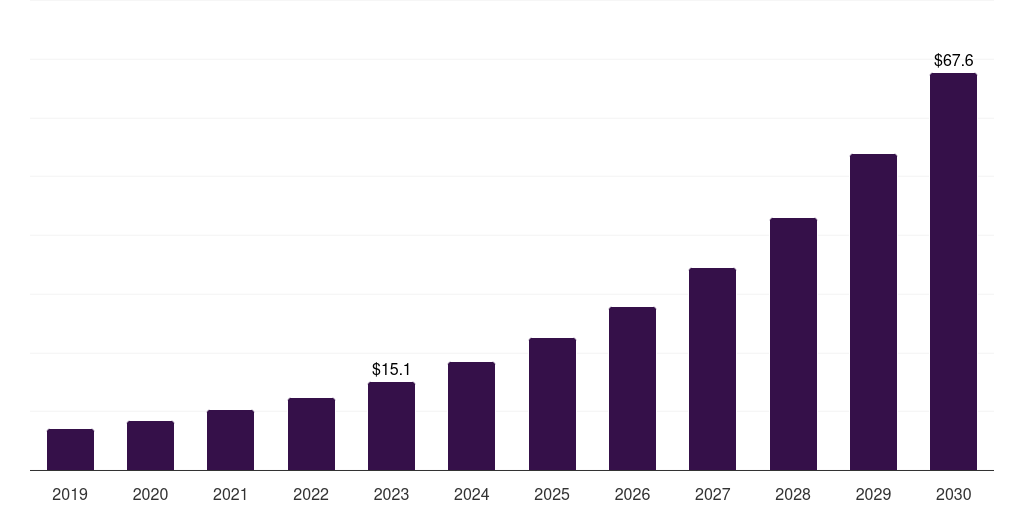Japan Electric Vehicle Plastics Market Size & Outlook
Japan electric vehicle plastics market, 2019-2030 (US$M)

Related Markets
Japan electric vehicle plastics market highlights
- The Japan electric vehicle plastics market generated a revenue of USD 15.1 million in 2023 and is expected to reach USD 67.6 million by 2030.
- The Japan market is expected to grow at a CAGR of 23.9% from 2024 to 2030.
- In terms of segment, polyurethane (pu) was the largest revenue generating resin in 2023.
- Polypropylene (PP) is the most lucrative resin segment registering the fastest growth during the forecast period.
Electric vehicle plastics market data book summary
| Market revenue in 2023 | USD 15.1 million |
| Market revenue in 2030 | USD 67.6 million |
| Growth rate | 23.9% (CAGR from 2023 to 2030) |
| Largest segment | Polyurethane (pu) |
| Fastest growing segment | Polypropylene (PP) |
| Historical data | 2019 - 2022 |
| Base year | 2023 |
| Forecast period | 2024 - 2030 |
| Quantitative units | Revenue in USD million |
| Market segmentation | Polypropylene (PP), Polyamide (PA), Polycarbonate (PC), Polyethylene (PE), Polyurethane (PU), Polyvinyl Chloride (PVC), Polyvinyl Butyral (PVB), Polybutylene Terephthalate (PBT), Acrylonitrile Butadiene Styrene (ABS), Polyethylene Terephthalate (PET) |
| Key market players worldwide | Basf SE, SABIC, LyondellBasell Industries NV Class A, Evonik Industries AG, Covestro AG, DuPont de Nemours Inc, Sumitomo Chemical Co Ltd, LG Chem, Asahi Kasei Corp, Lanxess AG, INEOS, Celanese Corp Class A, AGC Inc, Ems-Chemie Holding AG, Mitsubishi Electric Corp |
Other key industry trends
- In terms of revenue, Japan accounted for 0.6% of the global electric vehicle plastics market in 2023.
- Country-wise, China is expected to lead the global market in terms of revenue in 2030.
- In Asia Pacific, China electric vehicle plastics market is projected to lead the regional market in terms of revenue in 2030.
- India is the fastest growing regional market in Asia Pacific and is projected to reach USD 336.4 million by 2030.
No credit card required*
Horizon in a snapshot
- 30K+ Global Market Reports
- 120K+ Country Reports
- 1.2M+ Market Statistics
- 200K+ Company Profiles
- Industry insights and more
Electric Vehicle Plastics Market Scope
Electric Vehicle Plastics Market Companies
| Name | Profile | # Employees | HQ | Website |
|---|
Japan electric vehicle plastics market outlook
The databook is designed to serve as a comprehensive guide to navigating this sector. The databook focuses on market statistics denoted in the form of revenue and y-o-y growth and CAGR across the globe and regions. A detailed competitive and opportunity analyses related to electric vehicle plastics market will help companies and investors design strategic landscapes.
Polyurethane (pu) was the largest segment with a revenue share of 26.49% in 2023. Horizon Databook has segmented the Japan electric vehicle plastics market based on polypropylene (pp), polyamide (pa), polycarbonate (pc), polyethylene (pe), polyurethane (pu), polyvinyl chloride (pvc), polyvinyl butyral (pvb), polybutylene terephthalate (pbt), acrylonitrile butadiene styrene (abs), polyethylene terephthalate (pet) covering the revenue growth of each sub-segment from 2019 to 2030.
In 2021, Japan put forward a large funding package for offering purchase subsidies for electric vehicles and their charging to customers. The Strategic Energy Plan of the country was approved to support its net zero by 2050 target. In November 2021, the Government of Japan agreed to provide USD 342 million for e-mobility, by 2030.
Following the doubling of its subsidies in December 2020, the budget of Japan allocated USD 228 million for ZEV subsidies and the remainder for their charging infrastructures. Japan is transitioning to 100% electric car sales by 2035 and electric vehicles market in the country is continuously flourishing.
Reasons to subscribe to Japan electric vehicle plastics market databook:
-
Access to comprehensive data: Horizon Databook provides over 1 million market statistics and 20,000+ reports, offering extensive coverage across various industries and regions.
-
Informed decision making: Subscribers gain insights into market trends, customer preferences, and competitor strategies, empowering informed business decisions.
-
Cost-Effective solution: It's recognized as the world's most cost-effective market research database, offering high ROI through its vast repository of data and reports.
-
Customizable reports: Tailored reports and analytics allow companies to drill down into specific markets, demographics, or product segments, adapting to unique business needs.
-
Strategic advantage: By staying updated with the latest market intelligence, companies can stay ahead of competitors, anticipate industry shifts, and capitalize on emerging opportunities.
Target buyers of Japan electric vehicle plastics market databook
-
Our clientele includes a mix of electric vehicle plastics market companies, investment firms, advisory firms & academic institutions.
-
30% of our revenue is generated working with investment firms and helping them identify viable opportunity areas.
-
Approximately 65% of our revenue is generated working with competitive intelligence & market intelligence teams of market participants (manufacturers, service providers, etc.).
-
The rest of the revenue is generated working with academic and research not-for-profit institutes. We do our bit of pro-bono by working with these institutions at subsidized rates.
Horizon Databook provides a detailed overview of country-level data and insights on the Japan electric vehicle plastics market , including forecasts for subscribers. This country databook contains high-level insights into Japan electric vehicle plastics market from 2019 to 2030, including revenue numbers, major trends, and company profiles.
Partial client list
Japan electric vehicle plastics market size, by resin, 2019-2030 (US$M)
Japan Electric Vehicle Plastics Market Outlook Share, 2023 & 2030 (US$M)
Related industry reports
Related regional statistics
Sign up - it's easy, and free!
Sign up and get instant basic access to databook, upgrade
when ready, or enjoy our
free plan indefinitely.
Included in Horizon account
- 30K+ Global Market Reports
- 120K+ Country Reports
- 1.2M+ Market Statistics
- 200K+ Company Profiles
- Industry insights and more



